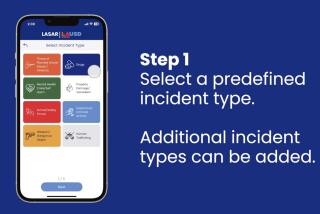Safe at Home : It’s Best to Exercise Caution in Selecting a Personal Security System for Older Singles
- Share via
To many senior citizens, Home Alone is not just the title of a movie. It’s reality.
And as America’s population ages, many adults have an elderly parent, aunt or uncle living alone. Safety and security concerns have prompted a growing use of personal alarm devices, the button-activated kind you wear to summon help in case of an emergency.
Called Personal Emergency Response Systems (PERS), these devices could soothe fears about an elderly relative or friend not being able to telephone for assistance.
More than 350,000 people now use such home-alert systems, but consumers should shop around before choosing one. Some companies operate their own monitoring facilities; others are established through local hospitals.
“These systems give confidence to older people and confidence to their middle-aged children,” says Lee Norrgard of the American Assn. of Retired Persons’ consumer division in Washington.
Although the systems vary among the 15 to 20 PERS companies, they typically operate through a radio transmitter worn or carried by the user, and a console connected to the user’s telephone. If the emergency button is pushed, a signal is transmitted through the console, which automatically dials the system’s monitoring center.
Some home response systems have only one-way communication--the response personnel must then call the user to determine the emergency, or send help if there is no answer. But the most popular, and more expensive, systems offer two-way voice communication so monitoring personnel can talk with the person needing help.
Personal alarm systems can be purchased or rented, but it is usually cheaper to rent. Rentals cost $25 to $50 a month, depending on the system and monitoring services. (Some companies charge extra for 24-hour monitoring.) Rental agreements are available on a yearly or monthly basis.
A PERS system can be bought for $400 to $4,000, with additional monitoring costs. Consumers should watch out for costs added to the base price.
Norrgard says that while AARP encourages use of home medical emergency systems, it does not endorse any particular company that sells them, and recommends that consumers rent.
“The greatest risk to the consumer is spending hundreds of dollars for equipment programmed to dial a response center which goes out of business,” he says, adding that consumers should find out how long a company has been in business.
Prospective customers also should beware of any company that uses high-pressure sales tactics without giving a price over the phone or permitting them to test the system before buying it. Wall thickness or the building materials in a house sometimes can affect the transmitter’s range--usually about 200 feet, industry experts say.
In the last few years, several PERS companies have been accused by consumer groups and some state attorneys general of using high-pressure sales tactics, AARP representatives report.
In the most recent action (September), for example, California Atty. Gen. Dan Lungren and district attorneys of eight counties filed a $2-million suit against Life Alert Emergency Response Inc. in Chatsworth. The suit alleges “coercive sales practices aimed primarily at seniors,” according to Jeffrey Holtzman, a deputy district attorney in Sonoma County, one of the counties participating in the lawsuit.
Holtzman said the suit also charged “misrepresentations of fact with respect to the effectiveness of its system to that of 911, leading consumers to believe they would get more favorable treatment than ordinary citizens calling 911. That’s untrue. They (Life Alert), in fact, call the 911 dispatch center, not an alternative dispatcher.”
Life Alert representative Eric Bordo, who denies all lawsuit allegations, says in written response to The Times’ questions that “we, like any other alarm company, usually utilize a seven-digit telephone number to communicate with the authorities.”
Bordo insists Life Alert is a burglar-alarm company that offers PERS as “an additional device” that could be purchased only with a full-service security system.
Although personal emergency alarm systems aren’t new, they are now a $150-million business, according to industry experts. The first was developed in 1974 by Drs. Andrew and Susan Dibner, founders of the oldest PERS company, Lifeline Systems Inc. in Watertown, Mass.
Lifeline representatives, whose company has supplied 70% of the PERS in use nationally today, project a 15% annual industry growth. Officials of that company and another, Lifewatch, also urge consumer caution.
“Consumers should be careful in choosing a company,” says Drew Greenblatt of Lifewatch, a Potomac, Md., firm established in 1983. “There are a lot of companies out there with very good products that I’d feel comfortable with if my grandmother had one. But there are a couple with dorsal fins in their backs.”
Lifewatch offers its system through hospitals in some states and also sells directly to consumers. Lifewatch can be purchased for $399, or rented for $35 a month, including 24-hour monitoring. It is a one-way transmitter system, but its console includes push-buttons to alert police and firefighters.
Lifeline does not sell directly to consumers. Its system, with two-way speakers, is offered through about 2,500 hospitals nationwide.
“Hospitals purchase the equipment from us, then set up a Lifeline program at their hospital,” says Jean Patel of Lifeline. “Consumers are then subscribers to the system through the hospital. They pay one monthly fee and don’t purchase the equipment. According to Patel, hospital fees for Lifeline range from $25 to $35 a month; some hospitals charge a one-time installation fee of $25 to $50.
Some hospitals and social service agencies offer PERS devices at low or no cost to low-income seniors or people with disabilities, according to AARP. And some insurance plans will cover the cost for a PERS if recommended by a physician.
Checking Out the System If you are shopping for a Personal Emergency Response System (PERS), experts recommend that you:
* Contact at least two companies so you can compare prices and features of the systems. Don’t deal with a company that refuses to give you a price on the phone.
* Ask the company representative if monthly monitoring is included in the quoted price of the rental or purchased system. Many have separate monitoring fees.
* Request a list of references for the company’s system and contact several users to see how they rate it.
* Inquire what procedures are followed when a call for help goes into the company’s monitoring center. Ask what kind of training the monitoring personnel receive.
* Ask what procedures are followed for testing a system in a users’ homes before purchasing or renting the device. Is testing conducted after you get the system installed and how often?
* If the system has a two-way voice capability, make sure you can hear and be heard from all parts of your home or apartment.
* Check with your local Better Business Bureau or other consumer groups to see if complaints have been filed about the PERS company’s services or system.
Source: American Assn. of Retired Persons
A free AARP pamphlet on personal emergency alarm systems--which offers tips and lists features of 12 brands -- is available by writing: AARP Fulfillment, PERS, 601 E St. NW, Washington, D.C. 20049.
More to Read
Inside the business of entertainment
The Wide Shot brings you news, analysis and insights on everything from streaming wars to production — and what it all means for the future.
You may occasionally receive promotional content from the Los Angeles Times.










